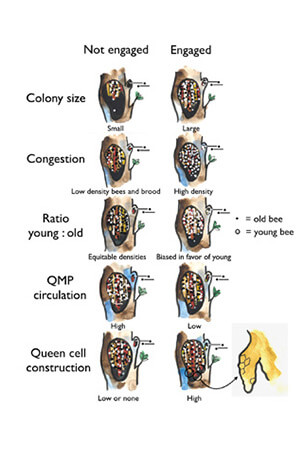Archived Columns
Mechanisms of Swarming in the Honey Bee Superorganism: Primer Conditions

In recent years, the subject of swarming – and what to do about it – has grown in importance in ways I never could have imagined as a young scientist or even younger beekeeper. Ever since C.L. Farrar’s pioneering work in 1937 showed a positive relationship between colony population size and honey crops1, beekeepers have rejected the whimsical notion that “a swarm of bees in May is worth a ton of hay” in favor of no swarms at all – the pursuit of unnaturally large colonies that make unnaturally large honey crops. Swarm control ranks somewhere around lessons #2 or 3 in every beekeeping short-course. It is highlighted in every beekeeping how-to book or chapter, a literature to which I have actively contributed, promoting the orthodoxy of swarm control as vigorously as I can.2,3,4 So when I feel compelled to pull back on my enthusiasm for swarm control in light of emerging evidence for its health risks to bees, I feel I can say so from a position of earned authority. As I have mentioned in some of my most recent columns, evidence is mounting that swarming has beneficial health effects on colonies; when colonies are left free to swarm they tend to have lower levels of brood diseases and parasitic mites.5,6 This seems to be a combined effect of age-based asymmetries in the bees that join the swarm7, the disruption in brood rearing, lowered nest congestion in the old cavity, and the prospects of a clean disease-free new cavity – all of which conspire to re-set the parasite clock backward. We need collaborative research between bee researchers and ag economists to determine whether the health benefits of increased swarming exceed the costs of reduced per-hive honey yield. It is a large-order question that must take into account the Whole Picture, weighing gains in colony health and survival against losses in per-hive yields and the likely need to increase hive numbers to maintain comparable production.
That said, I must now return to my theme in these articles – the evolutionary history of the honey bee and how beekeepers can use that knowledge to improve honey bee health. It is time we address swarming head-on, as it is arguably the fulcrum around which the annual life cycle of Apis mellifera turns. In this effort I have been greatly assisted by the excellent review by Grozinger and others.8 This month I am focusing on the primer conditions that ready a colony for swarming. In later installments I will dig into the immediate conditions that release, or trigger, a swarm event, then I will conclude with an analysis of the conditions that could cause natural selection to arrive at this complex mode of reproduction.
For swarming is, of course, reproduction at the scale of the superorganism. This is in contrast to reproduction at the scale of the individual, that is, the complex sequence of mating flights and multiple inseminations practiced by young queens and drones; the subsequent egg depositions by the mated queen; and the developmental stages of egg > larva > pupa > adult experienced by every member of the colony.
It is true, therefore, that when discussing reproduction in the honey bee we must be clear about which level we’re talking about. It is also true that the two types of reproduction are qualitatively different: individual reproduction, at least for workers, is sexual, involving the union of egg and sperm resulting in new chromosomal combinations, whereas superorganismal reproduction is asexual, analogous to binary fission of the kind practiced by single-celled organisms such as Paramecium and bacteria, literally a division of one body into two, each with identical genetic information. But it’s that part about identical genetic information where the analogy with single-celled organisms breaks down. Although reproductive fission in the superorganism does involve splitting one colony into two, as we will see in later installments, it also results in new gene combinations. A new swarm is not a clone of the parent colony from which it divided.
A successful swarm event is a coordinated interaction between the workers and the queen. It is also an extremely costly form of reproduction, compared, for example, to those insects that …
Figure 1. There are at least five primer conditions, or colony states, that regulate swarm preparations. These primers act on a time scale of weeks or months and set the stage for the eventual swarm event which operates on a time scale or hours or minutes. These primer states are, from top to bottom: (1) colony size, whether measured by worker population or combs, (2) brood nest congestion, whether worker population or brood, (3) high ratio of young : old workers, (4) decreasing efficiency of queen pheromone movement throughout the nest, and (5) queen cell construction. Large, congested colonies with a high ratio of young : old bees, with low efficiency of QMP distribution, and high rates of queen cell construction are optimally engaged for swarming.


